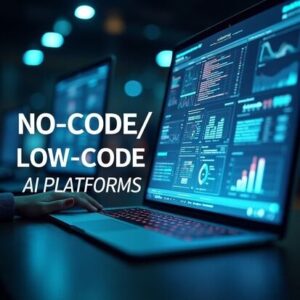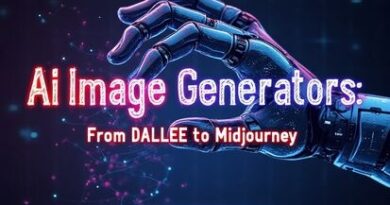No-Code/Low-Code AI Platforms
No-Code/Low-Code AI Platforms: Making AI Accessible to Non-Developers 🚀🧠
🎯 Introduction: Breaking Barriers with AI for All
In the past, building AI-powered applications required deep knowledge of machine learning, data science, and coding. Today, that barrier is being torn down by the rise of no-code/low-code AI platforms — empowering anyone, from students to entrepreneurs, to harness the power of AI without writing complex code.
These platforms open the door for innovation without the need for traditional programming skills. Whether you’re building a chatbot, analyzing data, or automating tasks, there’s a no-code or low-code AI solution for you.
Let’s explore what they are, how they work, real-world use cases, popular tools, and how you can get started today!
🤖 What are No-Code and Low-Code AI Platforms?
🔧 No-Code AI Platforms
These platforms allow users to create AI models or applications using drag-and-drop interfaces and visual workflows. You don’t need to write any code — just define inputs, select features, and launch your AI solution.
🔍 Low-Code AI Platforms
Low-code tools require minimal coding, often used for integrating AI into custom applications or tweaking complex logic. They offer more flexibility than no-code tools but still simplify the development process dramatically.

🧠 How No-Code/Low-Code AI Works Behind the Scenes
These platforms are built with powerful machine learning libraries, pre-trained models, and APIs hidden behind user-friendly interfaces.
Here’s what happens under the hood:
-
Data Ingestion: Upload datasets in formats like CSV, Excel, or Google Sheets.
-
Model Selection: Choose from pre-built models (e.g., image recognition, text classification).
-
Training: The platform handles model training, testing, and optimization.
-
Deployment: Deploy your model via API or UI integrations — all without worrying about infrastructure.
🌐 Why No-Code/Low-Code AI is a Game Changer
✅ Accessibility
Non-tech users like marketers, teachers, business owners, and students can create AI solutions without a background in coding or data science.
✅ Speed & Efficiency
Development that once took weeks can now be done in hours.
✅ Cost-Effective
Reduces the need for hiring data scientists or large development teams.
✅ Prototyping & Innovation
Quickly test and build ideas — great for startups and educators.
Also Read,
| College to Career Roadmap: Step-by-Step Guide for Students
STAR Method Explained-Answering Behavioral Interview Questions |
📚 Real-Life Use Cases of No-Code/Low-Code AI
🏫 1. Education
Teachers use AI tools like Teachable Machine by Google to create interactive models that recognize voice or images for classroom activities.
🏢 2. Business Automation
Non-tech employees automate document processing or customer service using Microsoft Power Automate and MonkeyLearn.
💬 3. Chatbots for Startups
Entrepreneurs deploy AI-powered chatbots using Landbot or Tars to answer queries and handle leads without hiring a developer.
🛍️ 4. E-commerce
Product recommendation engines can be created with Obviously AI or Akkio to personalize customer experiences.
📊 5. Data Analysis
Small businesses use tools like Peltarion or DataRobot to make predictions based on customer or sales data.
🛠️ Popular No-Code/Low-Code AI Platforms to Explore
🌟 1. Teachable Machine (Google)
Build image, audio, or pose recognition models in minutes — no code needed. Great for students and educators!
🌟 2. Akkio
A no-code AI platform that allows you to build and deploy models for classification, forecasting, and automation. Perfect for sales, marketing, and finance use.
🌟 3. Lobe (Microsoft)
Free desktop app to train machine learning models with images using a visual interface. Super beginner-friendly.
🌟 4. Peltarion
A low-code AI platform that lets users train, deploy, and manage deep learning models through a web-based interface.
🌟 5. DataRobot
While slightly more advanced, this platform allows low-code automation of machine learning tasks, used in enterprise environments.
🌟 6. MonkeyLearn
Easily analyze text data (like tweets, reviews, or surveys) with pre-built NLP models. Great for sentiment analysis and customer feedback.
🌟 7. Microsoft Power Platform
Combine Power Apps, Power BI, and Power Automate to create intelligent apps and dashboards with minimal coding.
📈 Real-World Example: How Students Use No-Code AI for Projects
Let’s take Ravi, a computer science student working on a final-year project. He has no experience with Python or TensorFlow but wants to create a machine learning model to detect plant diseases using leaf images.
Using Lobe by Microsoft:
-
He uploads 200 images.
-
Trains a classification model visually.
-
Tests and deploys it to a web app.
The result? A working AI model in 3 days — no code, no stress!
🧩 Key Components of a No-Code AI Workflow
Understanding the basic workflow helps you start strong:
-
Define Your Problem
What do you want the AI to do? (e.g., classify, recommend, predict, automate) -
Collect or Upload Data
Use spreadsheets, CSVs, or integrated tools like Google Sheets. -
Train Your Model
Select your input/output and allow the system to build the model. -
Test and Validate
Use test data to ensure accuracy. -
Deploy
Integrate via link, API, or embed into your website or app.
💡 Who Should Use No-Code/Low-Code AI Platforms?
These platforms are ideal for:
-
Students & Teachers – For interactive projects and learning tools.
-
Startups & Entrepreneurs – To rapidly prototype ideas.
-
Marketers – For sentiment analysis, lead scoring, and personalization.
-
Researchers – For quick experimentation and proof of concept.
-
Small Businesses – For automating daily operations without IT support.
🧭 Getting Started: A Beginner’s Roadmap
Here’s how you can dive into no-code AI even if you’re a complete beginner:
-
Explore Free Tools: Try Teachable Machine, Lobe, or MonkeyLearn.
-
Take Short Courses: Platforms like Coursera and edX offer beginner-friendly courses on AI without coding.
-
Start a Project: Pick a problem you care about — like classifying images or analyzing survey results.
-
Join Communities: Follow forums like Reddit’s r/NoCode, Indie Hackers, or join Discord channels for feedback.
-
Iterate and Share: Improve your model, and share your work on GitHub or your portfolio.
⚠️ Challenges of No-Code/Low-Code AI
While empowering, these platforms come with limitations:
🚫 Limited Flexibility
For complex projects, custom coding still wins.
🚫 Data Privacy Risks
Make sure the platform complies with GDPR or other privacy regulations when handling sensitive data.
🚫 Performance Constraints
No-code platforms may not perform well on large datasets or real-time data pipelines.
🚫 Vendor Lock-In
Once you build on one platform, migrating may be hard if features are proprietary.
🔮 The Future of No-Code/Low-Code AI
As AI becomes more ubiquitous, the demand for no-code tools will skyrocket. Here’s what the future holds:
-
AI that builds AI – Meta learning models will choose the best algorithms for your data.
-
Voice-to-App Builders – Describe what you want and get a working app!
-
Hyper-personalized learning – Education platforms where students build their own tools.
-
Cross-platform integration – No-code AI seamlessly linking with IoT, AR/VR, and blockchain.
This is just the beginning of democratizing AI for all.
📝 Conclusion: Build with AI, Not Just Code
No-code and low-code AI platforms are revolutionizing the way we think about artificial intelligence. You no longer need to be a data scientist to innovate. With the right tools, anyone — yes, even you — can build intelligent systems that solve real-world problems.
So whether you’re a student, a creative thinker, or an entrepreneur with big ideas — it’s time to unlock the power of AI without writing a single line of code. 🌟💡
📤 Stay Updated with NextGen Careers Hub
📱 Follow us on Instagram
📺 Subscribe to us on YouTube
Please share our website with others: NextGenCareersHub.in





